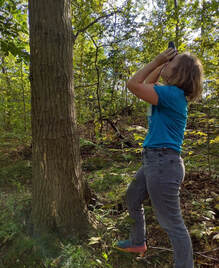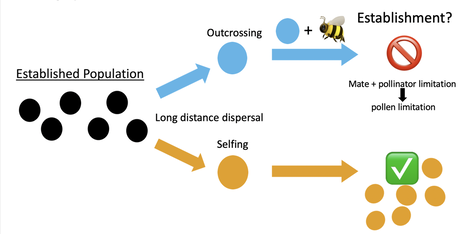
TREE LEAF PHENOLOGY AND CARBON SEQUESTRATION
Trees play an important role in regulating global climate because they store a lot of carbon. Decidious trees have a tradeoff between growth and survival and in the winter they lose their leaves and go dormant, ceasing carbon uptake. Broadly, we know that temperature and day length drives fall and spring leaf phenology in deciduous trees across large geographic scales, but we don't know what drives variation within species at a site. My goal is to characterize variation in fall leaf color change/drop and spring leaf out within species and determine if that variation is a result of micro-environment variation or genetic variation. Then, understand the impact of this variation on carbon sequestration.

MATING SYSTEMS AND COLONIZATION
With global change impacting species suitable habitats, many plant species will need to shift their ranges to escape extinction. Plant colonization theory suggests that species that can self-reproduce have an advantage over outcrossing species. The process of colonization leads to mate-limitation; therefore, if a plant requires outcross reproduction, it may be not be able to reproduce but a plant that can self-fertilize can use its own pollen in self-reproduction. I tested this hypothesis using reproductive variation in the Tall Bellflower (Campanula americana) by creating experimental colonization plots of high and low self-fertilizing plants at different population sizes. I found that high self-fertilizing plants performed better than low self-fertilizing plants, putting quantitative data behind a long-held hypothesis in the field!
Understanding the importance of plant mating systems during colonization can inform predictions of species distributions shifts with global change. This can help to determine both species and land conservation efforts
Publication: Makowski, H., K. Lamb, and L. F. Galloway. 2024. Support for Baker's law: Facultative self-fertilization ability decreases pollen limitation in experimental colonization. American Journal of Botany. e16351. https://doi.org/10.1002/ajb2.16351

MORPHOLOGICAL MECHANISMS OF MATING SYSTEM EVOLUTION
Many plant species have evolved mechanisms to promote outcross reproduction and prevent self-reproduction. The most common mechanism to prevent self-reproduction is for male and female reproductive functions occur at different times. The male function, pollen availability, often occurs first followed by the maturation of the female reproductive function. Therefore, for self-reproduction to occur a plant must circumvent the separation of male and female reproductive function. One potential mechanism of overlapping the two sexual phases is for a flower to retain pollen into female phase. If the pollen remains available as the female reproductive function matures, then self-reproduction can occur.
Some plant species have modified hairs along their reproductive structures that hold pollen. As flowers age, these pollen-collecting hairs retract and release pollen. My research has found intraspecific variation of the pollen-collecting hairs of the Tall Bellflower (Campanula americana) that is associated with mating system variation. I've also found that this variation spans over 50% of the phylogenetically constrained variation seen across 39 species from the Campanulaceae family, suggesting selection on mating system can break phylogenentically constrained relationships
Many plant species have evolved mechanisms to promote outcross reproduction and prevent self-reproduction. The most common mechanism to prevent self-reproduction is for male and female reproductive functions occur at different times. The male function, pollen availability, often occurs first followed by the maturation of the female reproductive function. Therefore, for self-reproduction to occur a plant must circumvent the separation of male and female reproductive function. One potential mechanism of overlapping the two sexual phases is for a flower to retain pollen into female phase. If the pollen remains available as the female reproductive function matures, then self-reproduction can occur.
Some plant species have modified hairs along their reproductive structures that hold pollen. As flowers age, these pollen-collecting hairs retract and release pollen. My research has found intraspecific variation of the pollen-collecting hairs of the Tall Bellflower (Campanula americana) that is associated with mating system variation. I've also found that this variation spans over 50% of the phylogenetically constrained variation seen across 39 species from the Campanulaceae family, suggesting selection on mating system can break phylogenentically constrained relationships
FLORAL SCENT
Floral scent plays a large role in pollinator attraction and has been shown to vary based on the sex of a flower. However, most of the sex-specific scent work has explored plants that flowers of a single sex (dioecy). My undergraduate research explored the sex-specific scent of a hermaphroditic flower (Canella winterana) that starts off as female and then switches to male. I found that there were differences in the floral scent profile between the sexual phases; however, these differences were not consistent across plants. The manuscript for this work is published in Biochemical Systematics and Ecology.
Floral scent plays a large role in pollinator attraction and has been shown to vary based on the sex of a flower. However, most of the sex-specific scent work has explored plants that flowers of a single sex (dioecy). My undergraduate research explored the sex-specific scent of a hermaphroditic flower (Canella winterana) that starts off as female and then switches to male. I found that there were differences in the floral scent profile between the sexual phases; however, these differences were not consistent across plants. The manuscript for this work is published in Biochemical Systematics and Ecology.
